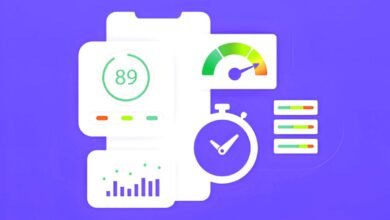How to Use Google Analytics 4 for Better Marketing Insights in the UK
Master Google Analytics 4 for better marketing insights in the UK. Learn GA4 setup, tracking, and strategies to boost your marketing ROI with real data.

If you run a business in the UK, you need to know what’s working with your marketing. Google Analytics 4 is the tool that shows you exactly what your customers are doing online. It tells you which pages people visit, how long they stay, and whether they buy something.
The old version of Google Analytics is gone, so now is the time to learn Google Analytics 4 for better marketing. This guide will help you understand Google Analytics 4 in simple terms and show you how to use it to make smarter business decisions.
Whether you own a shop, run a service business, or sell products online, understanding your data is the key to making more money and keeping customers happy.
What is Google Analytics 4 and Why Does It Matter?
Google Analytics 4 is a free tool made by Google that watches what happens on your website and app. Think of it like a security camera, but instead of filming people, it records their actions. It shows you when people click buttons, fill out forms, buy items, and leave your site.
The old version of Google Analytics stopped working in the middle of 2023. All UK businesses had to switch to GA4. This new version is smarter and better at understanding your customers. It uses something called “machine learning” (which just means artificial intelligence) to give you helpful hints about what might happen next.
Here’s why Google Analytics 4 for marketing insights matters so much:
- It tracks people across different devices (phone, tablet, computer)
- It shows the complete path a customer takes from finding you to buying
- It keeps your customer data private and follows UK privacy laws
- It works with other Google tools like Google Ads to help you spend your money wisely
- It gives you real-time updates so you can see what’s happening right now
Getting Started with GA4: The Setup Process
Creating Your GA4 Property
Setting up GA4 tracking is easier than you might think. Here’s what to do:
- Go to Google Analytics and sign in with your Google account
- Click on “Administration” (the gear icon)
- Choose “Create Property”
- Fill in your website name and pick the United Kingdom as your location
- Pick your industry category (e.g., retail, services, education)
- Tell Google what you want to measure (sales, leads, or just visits)
That’s it! Google will give you a code to put on your website. If you use WordPress or Shopify, there are simple apps that do this for you without needing code knowledge.
Installing the Tracking Code
Your GA4 tracking code is a small piece of instructions that watches your website. You need to put it on every page. Most people use something called Google Tag Manager to do this easily. It’s like a container that holds all your tracking codes in one place.
If you’re not technical, you can ask a web designer to help, or use your website builder’s built-in Google Analytics connection.
Understanding the Core Features of GA4
Event-Based Tracking: A Fresh Approach
The biggest change in Google Analytics 4 is how it tracks information. The old version counted “sessions” (how many times someone visited). GA4 counts “events” instead (what people actually do).
An event is any action on your website:
- Someone visits a page
- They fill out a contact form
- They add something to a shopping basket
- They click a button
- They watch a video
- They download a file
This event-based GA4 tracking gives you way more detailed information about what your customers really want. Instead of just knowing someone came to your site, you know exactly what they did while they were there.
Cross-Platform and Cross-Device Tracking
Most customers use more than one device. They might look at your website on their phone while at work, then check it on their computer at home, then use their tablet to buy.
Google Analytics 4 for marketing insights shows you this whole journey across all devices. It understands that the person on the phone is the same person on the computer. This complete picture helps you understand your customer journey much better. You see where people start and where they finish, which helps you improve your marketing.
Machine Learning and Predictive Insights
GA4 uses artificial intelligence to predict what might happen next. For example:
- It might tell you which visitors are most likely to buy in the next week
- It can warn you if visitors are getting ready to leave and never come back
- It shows you which marketing channels bring in the best customers
You don’t need to understand how it works. Just trust that it’s looking at all your data and finding patterns humans would miss. These marketing insights help you focus your efforts on what really works.
Key Metrics and Reports You Need to Know
The Most Important Metrics for UK Businesses
Not all numbers matter equally. Here are the metrics that really drive your business:
Traffic Metrics:
- Users: How many different people visit your site
- Sessions: How many total visits you get
- Page views: How many pages people look at
- Bounce rate: How many people leave without doing anything
Engagement Metrics:
- Average session duration: How long people stay
- Pages per session: How many pages they look at
- Engagement rate: The percentage of people doing something
Conversion Metrics:
- Conversions: How many people complete your goal (buy, sign up, call)
- Conversion rate: The percentage of visitors who convert
- Revenue: How much money you make
Pre-Built Reports That Save You Time
GA4 comes with ready-made reports that show you the most important stuff:
- Life Cycle Report: Shows how people find you, stay interested, and come back
- User Report: Tells you about your visitors (age, location, what device they use)
- Engagement Report: Shows which pages and content people like best
- Monetization Report: For online shops, shows what sells and what doesn’t
- Retention Report: Shows if people come back or disappear
These reports are set up to work right away. You don’t have to build them yourself.
Getting Better Marketing Insights Through GA4
Understanding Your Customer Journey
Your customers don’t just arrive and buy. They follow a path:
- Awareness: They find out you exist (through search, ads, social media)
- Consideration: They learn about your product and compare it to others
- Decision: They make up their mind to buy or contact you
- Action: They purchase or convert
GA4 for marketing insights shows you exactly where people enter this journey and where they drop out. Maybe lots of people see your ad but leave your website quickly. That’s a problem. Or maybe people read your blog posts but never call you. That’s a different problem. When you see where the problems are, you can fix them.
Using Audiences to Target Better
GA4 lets you create groups of visitors based on their actions. For example:
- People who visited your product page but didn’t buy
- Customers who purchased before and might buy again
- People who spent more than 5 minutes on your site
- Visitors from London or Manchester
You can then send these groups special ads on Facebook, Instagram, or Google. This is called audience segmentation, and it means you’re not wasting money showing ads to people who don’t care. You’re only talking to people who might actually buy.
Data-Driven Attribution
This is a fancy term for figuring out which marketing channels actually make people buy. Before someone purchases, they usually see your ads, click your search results, or follow your social media posts multiple times.
Old analytics tools only gave credit to the last click. So if someone saw your ad, then searched for you, then bought, it counted the search engine as making the sale. But really, the ad started them thinking about you.
GA4 is smarter. It looks at all the touchpoints and gives credit fairly. This helps you understand which marketing channels are actually worth money. Maybe you thought Facebook ads didn’t work, but GA4 shows they actually help by introducing people to you (even if someone doesn’t buy immediately after clicking).
Setting Up Conversion Tracking for Your Goals
Why Conversions Matter
A conversion is when someone does what you want them to do. For different businesses:
- An online shop: Someone buys
- A service business: Someone calls or fills out a form
- A blog: Someone signs up for your email list
- A local business: Someone finds your address and visits
Without tracking conversions, you’re flying blind. You might be spending money on marketing that brings lots of visitors but very few actual customers.
How to Set Up Conversion Goals
Setting up event tracking for conversions takes just a few steps:
- Go to GA4 and find “Events” in the settings
- Look for the action you want to track (a purchase, form submission, phone call)
- Click “Mark as conversion”
- Test it to make sure it’s working
- Wait for data to come in (usually takes a few hours)
Once it’s working, GA4 will show you conversion rate, how many conversions you get, and which marketing channels bring the best-converting visitors.
Using Conversion Data to Improve Your Website
Once you know your conversion numbers, you can improve them. For example:
- If your form gets lots of visitors but few conversions, maybe people can’t find it
- If people visit your pricing page but never buy, maybe your prices seem too high
- If people look at product pages but add nothing to the basket, maybe the description is confusing
The data from GA4 shows you the problems. Then you test different solutions to see what works better.
Connecting GA4 to Your Other Marketing Tools
GA4 and Google Ads Integration
Google Ads is where you buy search ads and display ads. When you connect it to GA4, something powerful happens.
Your GA4 data automatically shows up in Google Ads. You can see which ads bring in the best customers (not just the most clicks). You can create automatic rules: “Stop showing this ad if it’s not bringing conversions.” You can also upload your best customers’ data so Google can find more people like them.
This combination of GA4 for marketing insights and Google Ads is one of the most powerful ways to spend your advertising money wisely.
Learn more: Visit Google’s official guide to GA4 and Google Ads integration for detailed setup instructions.
Connecting Google Search Console
Google Search Console shows you which search words bring people to your website. When you connect it to GA4, you get the full picture:
- What words people search for
- How many people click your result
- What happens to them after they click
This helps with marketing insights about organic search. You might find that certain keywords bring lots of clicks but no conversions. Then you know to improve that page or stop paying for ads on that keyword.
Other Tool Integrations
GA4 connects to lots of other tools:
- Facebook and Instagram for better ad targeting
- Email marketing tools to track newsletter clicks
- Shopify for complete sales data
- CRM tools to track customer relationships
- HubSpot for complete inbound marketing tracking
Each connection gives you more complete information about your customers and helps you make better decisions.
Privacy, Data, and Staying Legal in the UK
GDPR and Data Privacy
The UK has strict data privacy laws (GDPR). This means you need permission before tracking someone’s personal information. Thankfully, GA4 can work without tracking personal details.
Here’s what to do:
- Put a cookie banner on your website explaining you use analytics
- Let people opt out of tracking if they want
- Use GA4‘s privacy features to turn off certain tracking
- Make sure you’re collecting what you actually need
The good news is that GA4 is built to work with these laws. It uses “first-party data” (information from your own website) instead of sharing data with other companies.
First-Party Cookies vs. Third-Party Cookies
Third-party cookies are disappearing. These are tracking codes that follow people across different websites. Soon browsers won’t allow them anymore.
GA4 uses first-party cookies instead. These only work on your website. So GA4 isn’t as good at tracking people across the internet, but it’s better at understanding what happens on your specific site. For most UK businesses, this is actually better anyway.
Common Mistakes to Avoid
Tracking Mistakes
New GA4 users often make these errors:
- Not setting up proper goals: They watch data but don’t know if it’s good or bad
- Ignoring mobile data: Over half of UK web traffic comes from phones, but they focus on desktop only
- Forgetting to check regularly: They set it up then ignore it for months
- Not filtering out their own visits: Their own team’s clicks mess up the data
- Mixing up sessions and users: They think a visitor came 10 times, but really the same person visited 10 times
Analysis Mistakes
Getting the data is only half the battle. Here’s how people get it wrong:
- Only looking at big numbers: They see 1,000 visitors and think it’s good, but maybe they should have 10,000
- Not comparing over time: They don’t know if things are getting better or worse
- Ignoring small segments: They look at overall data but miss that one traffic source is much better
- Changing everything at once: They fix the website and change ads at the same time, so they don’t know which helped
Making an Action Plan Based on Your GA4 Data
Step-by-Step: From Data to Action
Don’t just look at numbers. Use them to improve your business:
- Watch for 2-4 weeks and see which pages people visit most
- Look at your conversion rates for each traffic source
- Identify your best performers (pages, ads, content, channels)
- Test a small change on your worst-performing pages
- Measure if it helps (usually takes 1-2 weeks of data)
- If it works, keep it and test something else
- Repeat forever because marketing always changes
This method is called testing, and it works. Instead of guessing, you let real customer data guide you.
Creating Regular Reports
Don’t drown in data. Create one simple report that shows what matters:
- How many visitors this month vs. last month
- Your conversion rate
- Your cost per conversion (if you run ads)
- Your top 3 pages
- Your top 3 traffic sources
Print this or email it to your boss every month. It tells the full story in one page.
Advanced GA4 Features to Explore Later
Once you’re comfortable with the basics, try these:
- Custom events: Track specific things unique to your business
- Audiences: Create groups of visitors for targeting
- Explorations: Deep dive into specific questions about your data
- Predictive insights: Let AI forecast future trends
- Real-time reports: See what’s happening right now
More resources: Check Google’s comprehensive GA4 documentation to learn these advanced features step-by-step.
Conclusion
Google Analytics 4 for better marketing insights is now the standard tool every UK business needs. It shows you what customers do on your website, which marketing channels work best, and where you’re losing people. Start by setting up basic tracking and conversion goals, then use your data to make small improvements over time.
Connect GA4 to your other tools like Google Ads for more power. Remember that data without action means nothing—the real magic happens when you use what GA4 teaches you to build a better website and better marketing.
Test small changes, measure results, and keep improving. Your competitors are probably still guessing or using old tools, which means understanding GA4 tracking and your customer journey gives you a real advantage in growing your UK business.







